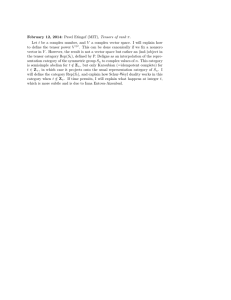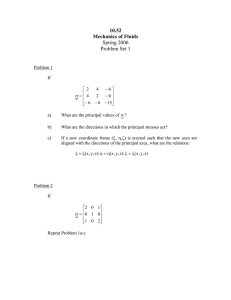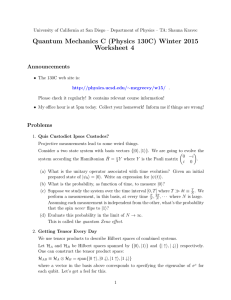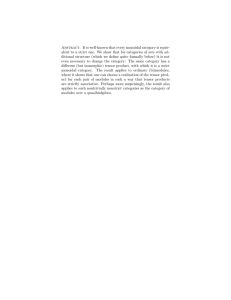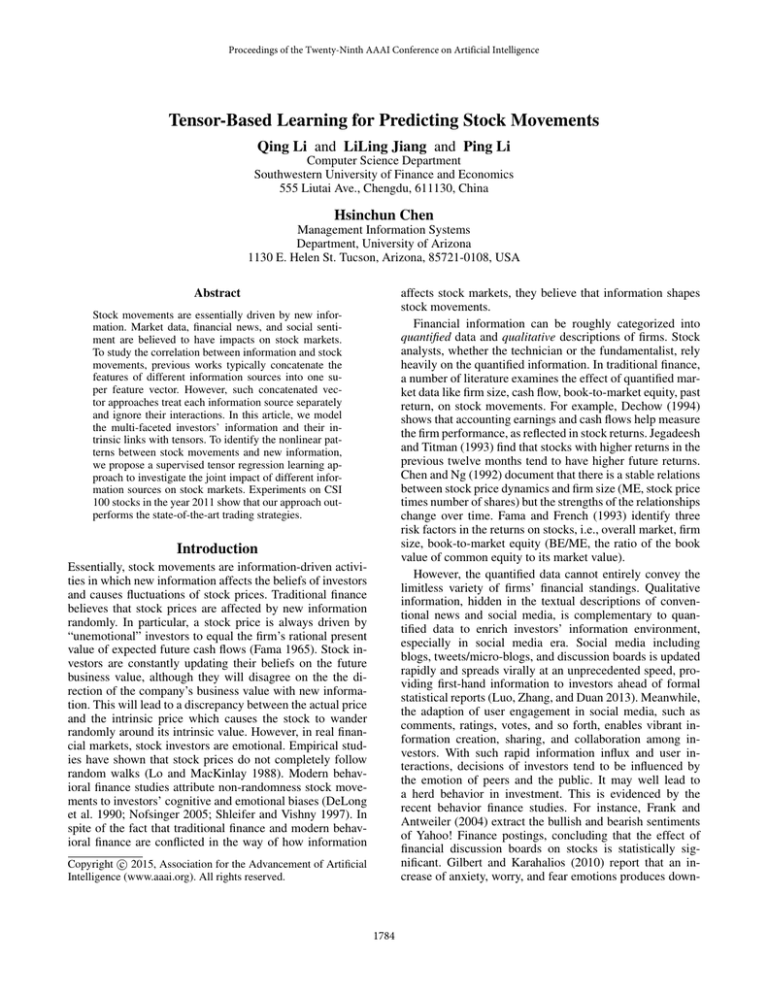
Proceedings of the Twenty-Ninth AAAI Conference on Artificial Intelligence
Tensor-Based Learning for Predicting Stock Movements
Qing Li and LiLing Jiang and Ping Li
Computer Science Department
Southwestern University of Finance and Economics
555 Liutai Ave., Chengdu, 611130, China
Hsinchun Chen
Management Information Systems
Department, University of Arizona
1130 E. Helen St. Tucson, Arizona, 85721-0108, USA
affects stock markets, they believe that information shapes
stock movements.
Financial information can be roughly categorized into
quantified data and qualitative descriptions of firms. Stock
analysts, whether the technician or the fundamentalist, rely
heavily on the quantified information. In traditional finance,
a number of literature examines the effect of quantified market data like firm size, cash flow, book-to-market equity, past
return, on stock movements. For example, Dechow (1994)
shows that accounting earnings and cash flows help measure
the firm performance, as reflected in stock returns. Jegadeesh
and Titman (1993) find that stocks with higher returns in the
previous twelve months tend to have higher future returns.
Chen and Ng (1992) document that there is a stable relations
between stock price dynamics and firm size (ME, stock price
times number of shares) but the strengths of the relationships
change over time. Fama and French (1993) identify three
risk factors in the returns on stocks, i.e., overall market, firm
size, book-to-market equity (BE/ME, the ratio of the book
value of common equity to its market value).
However, the quantified data cannot entirely convey the
limitless variety of firms’ financial standings. Qualitative
information, hidden in the textual descriptions of conventional news and social media, is complementary to quantified data to enrich investors’ information environment,
especially in social media era. Social media including
blogs, tweets/micro-blogs, and discussion boards is updated
rapidly and spreads virally at an unprecedented speed, providing first-hand information to investors ahead of formal
statistical reports (Luo, Zhang, and Duan 2013). Meanwhile,
the adaption of user engagement in social media, such as
comments, ratings, votes, and so forth, enables vibrant information creation, sharing, and collaboration among investors. With such rapid information influx and user interactions, decisions of investors tend to be influenced by
the emotion of peers and the public. It may well lead to
a herd behavior in investment. This is evidenced by the
recent behavior finance studies. For instance, Frank and
Antweiler (2004) extract the bullish and bearish sentiments
of Yahoo! Finance postings, concluding that the effect of
financial discussion boards on stocks is statistically significant. Gilbert and Karahalios (2010) report that an increase of anxiety, worry, and fear emotions produces down-
Abstract
Stock movements are essentially driven by new information. Market data, financial news, and social sentiment are believed to have impacts on stock markets.
To study the correlation between information and stock
movements, previous works typically concatenate the
features of different information sources into one super feature vector. However, such concatenated vector approaches treat each information source separately
and ignore their interactions. In this article, we model
the multi-faceted investors’ information and their intrinsic links with tensors. To identify the nonlinear patterns between stock movements and new information,
we propose a supervised tensor regression learning approach to investigate the joint impact of different information sources on stock markets. Experiments on CSI
100 stocks in the year 2011 show that our approach outperforms the state-of-the-art trading strategies.
Introduction
Essentially, stock movements are information-driven activities in which new information affects the beliefs of investors
and causes fluctuations of stock prices. Traditional finance
believes that stock prices are affected by new information
randomly. In particular, a stock price is always driven by
“unemotional” investors to equal the firm’s rational present
value of expected future cash flows (Fama 1965). Stock investors are constantly updating their beliefs on the future
business value, although they will disagree on the the direction of the company’s business value with new information. This will lead to a discrepancy between the actual price
and the intrinsic price which causes the stock to wander
randomly around its intrinsic value. However, in real financial markets, stock investors are emotional. Empirical studies have shown that stock prices do not completely follow
random walks (Lo and MacKinlay 1988). Modern behavioral finance studies attribute non-randomness stock movements to investors’ cognitive and emotional biases (DeLong
et al. 1990; Nofsinger 2005; Shleifer and Vishny 1997). In
spite of the fact that traditional finance and modern behavioral finance are conflicted in the way of how information
c 2015, Association for the Advancement of Artificial
Copyright Intelligence (www.aaai.org). All rights reserved.
1784
ward pressure on the S&P 500 index. Bollen, Pepe, and
Mao (2011) capture the public mood from tweets to forecast stock movements. Yu, Duan, and Cao (2013) show that
social media has a stronger relationship with firm stock market performance than conventional media. Luo, Zhang, and
Duan (2013) study the predictive relationship between social
media and firm equity value, and find that Web blogs and
consumer ratings are the two most significant leading indicators of firm equity value in social media. Li et al. (2014a;
2014b) propose a media-aware quantitative trader capturing
public mood from interactive behaviors of investors in social
media, and study the impact of firm-specific news sentiment
on stocks along with this public mood.
Essentially, the information related with markets is multifaceted and multi-relational. The primary sources (modes)
include event-specific, firm-specific, and sentiment information. Such complex information, referred to as a mosaic notion of investors’ information environment (Francis, Douglas Hanna, and Philbrick 1997), implies the joint influence
of different information sources on stock movements. The
way to explore such joint impact remains a great challenge
in computational investing, which is critical to understand
the invisible hand of stock markets. The challenge lies in negotiating the “semantic gap” while mingling these low-level
features with the high-level concepts.
The common strategy in previous studies (Lavrenko et al.
2000; Li et al. 2014a; Mittermayer and Knolmayer 2006;
Schumaker and Chen 2008; 2009b; Schumaker et al. 2012;
Wang, Huang, and Wang 2011; Xu and Zhang 2013; Yu,
Duan, and Cao 2013) is to concatenate features of different information sources into one super feature vector, whose
high dimensionalities always cause the problem of “curse
of dimensionality” (Bellman and Dreyfus 1962). More importantly, from “mosaic” perspective, different information
sources are interlaced and interacted to construct the complex investors’ information space. With the concatenated
vector representation, each vector element is assumed to be
independently, and the contextual coocurrence relations between different information sources are somehow weakened,
even ignored. For example, two positive news articles about
a stock may be textually dissimilar, since nature language
is rich and diverse. Contrastingly, the quantified statistics of
profits, sales, debt levels, and dividends showing a good investing chance may strengthen the semantic similarities of
different words in these two articles. It is necessary to propagate and reinforce these contextual coocurrence relations
among different information sources to capture the nonlinear patterns between stock movements and new information.
In this article, we employ the algebra of higher-order tensor to model the multi-faceted investors’ information and
their intrinsic links. It provides a generalizable and scalable
framework to analyze the complex investors’ information
on stock movements, in which the multi-faceted factors are
complementary to each other. To identify the nonlinear patterns between stock movements and new information, we
propose a supervised tensor regression learning approach to
investigate the joint impact of different information sources
on stock markets. It provides a powerful methodology for
financial researchers to explore the impact of qualitative in-
Figure 1: Design Scheme.
formation and quantified data on stock movements.
System Framework
In this study, we implement a tensor-based stock information analyzer, dubbed TeSlA, to systematically study the
information impact on stocks. The framework of TeSlA is
sketched in Figure 1. It first represents three types of information sources as tensors. Tucker decomposition is then applied to remove noise and capture intrinsic links of different
modes in these tensors. These transformed information tensors are feed into the predictive model for predicting future
stock movements.
Investors’ Information Modeling
There are various of information factors on stock movements which have been studied extensively before. Traditional finance mainly focuses on the long-term impact
of firm-specific factors (Cheung and Ng 1992; Dechow
1994; Fama and French 1993; Jegadeesh and Titman 1993),
whereas modern behavioral finance is interested in the shortterm shock of sentimental factors and event-specific factors (Bollen, Pepe, and Mao 2011; Frank and Antweiler
2004; Gilbert and Karahalios 2010; Schumaker and Chen
2009b; Tetlock, Saar-Tsechansky, and Macskassy 2008). It
is critical to model the complex investors’ information space
of different information sources, and study their joint impact on stocks. In this study, we construct investors’ information space in terms of three different types of information
sources, i.e., firm, event, and sentiment. In particular,
• Firm-specific Mode: The stock price reflects the intrinsic value of a firm. Investors generally have higher expectations on healthy companies. Here, we select six key
characteristics of a company to capture its future business
value, each of which shows a predictive ability to some
degree in previous literatures (Fama and French 1993;
Li et al. 2014a; 2014b). That is, stock price, trading
volume, turnover, price-to-earnings (P/E) ratio, price-tobook (P/B) ratio, and industry category.
• Event-specific Mode: Stock investors are constantly updating their beliefs about the direction of the market with
new information, which leads to fluctuations of stock
prices. Recent studies show that news articles play an important role in short-term stock movements (Fama and
French 1993; Li et al. 2014a). Therefore, we utilize news
articles as the event-specific information factor. Specifically, each news article is represented as a term vector,
1785
Tensor Decomposition & Reconstruction
Once represent investors’ information with tensors, a decomposition technique is applied to derive latent relationships between different information modes. CP and Tucker
decomposition are the two most popular tensor decomposition methods (Kolda and Bader 2009). In this article, we
apply Tucker decomposition to derive latent relationships
inherent in a tensor. Essentially, Tucker decomposition is
a form of higher-order PCA. It decomposes a tensor into a
core tensor multiplied by a matrix along each mode.
Figure 2: Investors’ Information via Tensor Representation.
A snapshot of information stream at time t is 3rd-mode data
tensor Xt which can be summarized by a core tensor and
three factor matrices via Tucker decomposition.
Definition 1 (Tucker Decomposition) Tucker decomposition of
X ∈ RI1 ×···×IM yields a core tensor C of specified size R1 ×
Im ×Rm
such that
· · · × RM and factor matrices Um |N
m=1 ∈ R
X ≈C
where each entry is a weighted noun and sentiment word
extracted from the article (Li et al. 2014b).
M
× m Um ,
(1)
m=1
M
i.e., the reconstruction error e = ||X − C m=1 ×m UTm || is
minimized. Here, ×m denotes the mode-m product.
Figure 2 depicts the Tucker decomposition of the thirdorder tensor. The third-order tensor X is decomposed as
C ×1 U1 ×2 U2 ×3 U3 . Here, factor matrices, U1 , U2 , and
U3 , describe one distinct facet of the investors’ information,
i.e., firm, event, and sentiment, respectively. The core tensor,
C, indicates the strength of relationships among three facets.
Each information mode is represented by an “order” in tensor, which considers the difference of scale. During the tensor decomposition, the hidden compensations and interactions between different modes are emphasized and strengthened. It overcomes the weakness of the concatenated feature
vectors in previous studies which ignores not only the scale
difference of different modes but also their correlations and
interactions.
After decomposition, we reconstruct a new tensor, X̂ ,
which is able to reveal the latent information relationship
of firms, events, sentiment in the form of new entries. The
reconstruction transformation is equivalent to the tensor operation X̂ = C ×1 U1 ×2 U2 ×3 U3 with the computational
cost O(N ) where N = I1 + I2 + I3 . Let A and  be the
set of tenor entires in X and X̂ , respectively. The reconstructed tensor X̂ consists of a set of triplets â(i, j, k) ∈ Â,
where A ⊂ Â. Each â(i, j, k) indicates the intrinsic relations
among the information related with firm, event, and sentiment. Figure 3 shows a simplified example of this transformation, which obtains the enhanced knowledge to identify
the interactions and correlations between different information modes. The original tensor X ∈ R3×3×5 is decomposed
into one core tensor C ∈ R2×2×2 , and three factor matrices
of U1 ∈ R3×2 , U2 ∈ R3×2 , and U3 ∈ R5×2 , when we
choose 2 as the reduction size. The reconstructed tensor X̂
is derived by multiplying the core tensor and three factor
matrices. It can be observed that tensor decomposition and
reconstruction has updated the value for each existing entries indicating its importance and identify some new entries
showing the latent relationships.
• Sentiment Mode: With the popularity of social media, it
provides an important platform to share opinions or feelings among investors. In real financial market, irrational
investors tend to be influenced by peers, most likely leading to a herd behavior in investing (DeLong et al. 1990).
Previous studies put forward an effective way to capture social sentiment by tracking the changes of emotion words in social media (Bollen, Pepe, and Mao 2011).
Here, we capture social sentiment in terms of the positive
and negative mood of investors as the way proposed by Li
et al. (2014b).
The multiple modes of investors’ information are complementary in essence, which could interact on each other. In
this article, the investors’ information environment is modeled in the form of tensor streams, a snapshot of investors’
information at time t is represented as order-3 tensor Xt .
Essentially, a tensor is a mathematical representation of a
multi-way array. A first-order tensor is a vector, a secondorder tensor is a matrix, and tensors of order three is called
3rd-order tensors. More details of the tensor algebra can be
found in Kolda and Bader (2009). Note that we use x to denote a vector, X denote a matrix, and X a tensor.
Figure 2 illustrates an example 3rd-order tensor, Xt ∈
RI1 ×I2 ×I3 , representing the three-way relations of firmspecific, event-specific, sentiment information at time t.
Here, I1 , I2 , and I3 are the dimensions of firm-specific features, event-specific features, and sentiment features, respectively. The element values ai1 ,i2 ,i3 of each information snapshot at time t are defined as:
• ai1 ,1,1 denotes features of firm-specific information;
• a2,i2 ,2 denotes features of event-specific information;
• a3,3,i3 denotes features of sentiment information;
• other elements are set to zeros originally.
Thus, investors’ information can be represented by a tensor
stream instead of a vector stream in traditional approaches.
Each order of a tensor represents a subspace of one information mode.
Tensor-based Supervised Learning
Predicting stock movements is essentially a supervised
learning problem. In this study, investors’ information is
1786
N
N
N
1
(ξi + ξi∗ ) −
ηi ξi −
ηi∗ ξi∗
L = ||uvT ||2 + C
2
i=1
i=1
i=1
N
−
αi (ε + ξi − yi + uT Xi v + b)
i=1
N
−
αi∗ (ε + ξi∗ + yi − uT Xi vb).
i=1
(3)
Here, L is the Lagrangian and αi , αi∗ , ηi , ηi∗ are Lagrange
multipliers. Note that: 12 ||uvT ||2 = 12 (vT v)(uT u). Thus, L
is rewritten as
N
N
1 T
T
∗
(ξi + ξi ) −
ηi ξi
L = (v v)(u u) + C
2
i=1
i=1
Figure 3: Example of Tensor Transformation.
modeled with a tensor stream {X1 , X2 , . . . , XN }, and the
corresponding stock trend indicator such as stock earning,
index, and price at time i is denoted as yi . Our goal is to find
the hidden patterns between Xi and yi . It can be converted
to a high-dimensional regression problem. In particular, find
a tensor function f (X ) that has at most ε deviation from the
actually obtained targets yi for all the training data. That is,
we do not care about errors as long as they are less than ε, but
will not accept any deviation larger than this. This definition
is analogous to the support vector regression (SVR) (Smola
and Schölkopf 2004). Essentially, SVR is a special case of
our study in which the input data is 1st-order tensor (vector).
In following part, we first explain the proposed supervised
learning algorithm in the form of 2nd-order tensor, and extended it to higher-order tensor.
−
−
J(u, v, b, ξi , ξi∗ ) =
αi∗ (ε + ξi∗ + yi − uT Xi v − b) (4)
i=1
αi (ε + ξi − yi + uT Xi v + b).
i=1
u=
N
∗
i=1 (αi − αi )Xi v
vT v
i = 1, · · · , N.
(5)
N
− αi∗ )uT Xi
i = 1, · · · , N.
(6)
uT u
As shown in Equations (5) and (6), u and v are dependent
on each other, and can not be solved independently. Therefore, we can apply the iterative approach to solve this problem. In particular, first, let u = (1, . . . , 1)T , xi = XTi u, and
β1 = ||u||2 , v can be computed by solving the following
optimization problem:
v=
min
v,b,ξi ,ξi∗
i=1 (αi
J(v, b, ξi , ξi∗ )
N
1
= β1 ||v||2 + C
(ξi + ξi∗ )
2
i=1
⎧
T
⎨ y i − v xi − b ≤ ε + ξ i ,
T
subject to v xi + b − yi ≤ ε + ξi∗ ,
⎩ ∗
ξi , ξi ≥ 0, i = 1, · · · , N.
1
(ξi + ξi∗ )
||uvT ||2 + C
2
i=1
⎧
T
⎪
⎨yi − < X, uv > −b ≤ ε + ξi ,
subject to < X, uvT > +b − yi ≤ ε + ξi∗ ,
⎪
⎩ξ ∗ , ξ ≥ 0, i = 1, · · · , N.
i
i
N
N
It follows from the saddle point condition that the partial
derivatives of L with respect to the variables (u, v, b, ξi , ξi∗ )
have to vanish for optimality. This gives the conditions:
Here, the model complexity is measured by
||uvT || (Smola and Schölkopf 2004). Instead of limiting the function f (X) actually exists that approximates all
pairs (Xi , yi ) with ε deviation, we introduce slack variables
ξi , ξi∗ to allow mapping errors. Therefore, we can write this
problem as a convex optimization problem:
u,v,b,ξi ,ξi∗
ηi∗ ξi∗ −
i=1
Definition 2 (Learning problem) Given a set of training data
{(X1 , y1 ), (X2 , y2 ), . . . , (XN , yN )}, where 2nd-order tensor (matrix) Xt ∈ RI1 ×I2 denotes the input, and yt ∈ R is the output associated with Xt , find a 2nd-order tensor mapping function
f (X) = uT Xv + b, where u ∈ RI1 , v ∈ RI2 , and b ∈ R, that has
at most ε deviation from the actually obtained targets yi for all the
training data, and at the same time the complexity of the model is
as low as possible.
min
N
N
(7)
Once v is obtained, let β2 = ||v||2 , and x̂i = Xi v. Thus, u
can be obtained by solving the following optimization problem:
(2)
where C is a positive constant parameter used to control the
tradeoff between the model complexity and the amount up
to which deviations larger than ε are tolerated. To solve this
optimization, the key idea is to construct a Lagrange function from the objective function and the constraints by introducing a dual set of variables. Therefore, we proceed as
follows:
min ∗ J(u, b, ξi , ξi∗ ) =
u,b,ξi ,ξi
⎧
T
⎨yi − u x̂i − b ≤ ε + ξi ,
T
subject to u x̂i + b − yi ≤ ε + ξi∗ ,
⎩ ∗
ξi , ξi ≥ 0, i = 1, · · · , N.
1787
N
1
(ξi + ξi∗ )
β2 ||u||2 + C
2
i=1
(8)
Table 1: Tensor-based Learning Algorithm
I1 ×I2 ×I3
Input:
Tensor stream Xi |N
i=1 ∈ R
N
Indicators yi |i=1 ∈ R.
Output: The parameters in tensor function
f (X ) = X ×1 W1 ×2 W2 ×3 W3 + b,
i.e., Wk |3k=1 ∈ RIk , and b, and corresponding
∗ N
slack variables ξi |N
i=1 ∈ R, ξi |i=1 ∈ R.
3
Step 1: Set Wk |k=1 equal to random unit vectors;
Step 2: Do steps 3-7 iteratively until convergence;
Step 3: From m = 1 to 3
Step 4:
Set βk,k=m = ||Wk ||2 ,
k=m
xi,1≤i≤N = Xi 1≤k≤3 ×k Wk ;
Step 5:
Obtain Wm by optimizing
min ∗ J(Wk , b, ξ, ξ ∗ ) =
Wk ,b,ξ,ξ
1
2
k=m
1≤k≤3
⎧
⎪
⎨
s.t.
Step 6:
Step 7:
Step 8:
⎪
⎩
βi ||Wm ||2 + C
N
i=1
Table 2: Comparison (Vector vs. Tensor)
Method
RMSE Direction
SVR
0.6396
57.01%
PCA+SVR
0.6132
58.03%
ISOMAP+SVR
0.6054
58.74%
Our tensor-based approach 0.5818
61.78%
• Stock Data: It contains the high-frequency financial data
during Jan.1, 2011 and Dec.31, 2011. It provides intraday
transaction information including price, volume and time
in the second-level.
In our experiments, we used the data from the first 9
months of 2011 as a training corpus and the last 3 months
of 2011 for testing. We removed several companies from the
available 100 companies due to inconsistencies and abnormalities. In our testing period, the upward trend was 46.12%,
the downward trend was 49.53%, and the remaining percentage was still. The standard deviation of the stock prices in
this testing period was 27.12. Here, closeness and directional
accuracy are used as the evaluation metrics. Directional accuracy measures the percentage of price forecast with right
directions in the total forecast. Root Mean Squared Error
(RMSE) between the predicted value and the real stock price
is used as the closeness metric.
(ξi + ξi∗ )
yi − WTm xi − b ≤ ε + ξi
WTm xi
∗
ξ i , ξi ≥
+ b − yi ≤ ε + ξi∗
0, i = 1, · · · , N
End
Convergence Checking
End
Note that optimization problem (7) and (8) can be solved
by a standard SVR algorithm. Any computational method
for SVR can also be used here. This iterative procedure to
update u and v is carried on until the objective function converges.
While Tucker decomposition, the relations of different information mode (firm, event, sentiment) of a tensor are reinforced (vertical compensation). During the iterative optimization, the intrinsic links of different modes are strengthened across the timeline (horizontal interaction). This allows
us to study the joint impact of different information modes
on stock movements. With the solution of iterative optimization, the learning algorithm in the form of 2nd-order tensor
can be straightly extended to 3rd-order tensor or even the
higher order tensor. The generalized tensor-based regression
learning algorithm is given in Table 1.
Time Window of Prediction
There exists a time window to foreseen the direction of
a stock with the release of new information (Chan 2003;
Gidofalvi 2001). A “20-minute” theory shows that an optimal outlook time window to sense stock movement is
approximately 20 minutes after introducing new information (Gidofalvi 2001; Li et al. 2014a; Schumaker and Chen
2009a). In our study, we also observe the “20-minute” phenomena, and find that the best predictive performance is
achieved while predicting +26-minute future prices after
news releases. This finding indeed agrees with the previous
research that reported the existence of lag time between information introduction and stock market correction to equilibrium (LeBaron, Arthur, and Palmer 1999).
Joint Impact of Investors’ Information
Experimental Evaluation
Comparing with previous concatenated vector approaches,
the advantage of the proposed tensor-based learning algorithm is able to model the multi-faceted factors and their
intrinsic links of the complex investors’ information. To investigate the effect of the proposed approach, we compare
our tensor-based approach with the following vector-based
approaches:
The ultimate goal of this study is to examine the effectiveness of the proposed tensor-based learning approach to capture the joint impact of different information modes on stock
movements. In our experiments, we use the stock data generously provided by Li et al. (2014b). It consists of three
parts:
• Financial News: It contains 124, 470 financial news articles related with 100 companies listed in China Securities
Index (CSI 100).
• Discussion Board: It contains the discussion threads of
CSI100 companies during Jan.1, 2011 and Dec.31, 2011
from two premier financial discussion boards in China,
i.e., Sina.com and EastMoney.com.
• SVR: SVR is directly applied to the original concatenated
vector which consists of firm-specific, event-specific, and
sentiment information features.
• PCA+SVR: PCA is firstly applied to the original concatenated vector to reduce the vector dimension, and then
SVR is performed on the dimension-reduced vector.
1788
aware trader, AZFinText (Schumaker and Chen 2009b). We
set RMB10,000 (approximately USD1,630) as the investment budget and compare the daily earnings of these approaches in our 3-month evaluation period, during which the
CSI Index was down by 5.21% from 2,363 to 2,240.
In our experiments, even with the optimal top-30 combination, a small loss is still experienced for Top-N approach.
Different from the long-term strategy Top-N , SMA focuses
on short-term transactions. The SMA strategy is triggered
when an actual market stock price crosses through the daily
moving average of the same stock. There is no positive earnings with SMA within the 3-month assessment time. AZFinText (Schumaker and Chen 2009b) is a media-aware trading
system as TeSIA. It applies SVR model to capture the correlation between financial news and stock prices. Comparing
the change of -5.21% in CSI100 and the 103.23% return in
AZFinText, the proposed TeSIA yields a remarkable return
of 235.20% in three months.
Table 3: Vertical & Horizontal Compensation
Method
Without iterations
Without Tucker
Our tensor-based approach
RMSE
0.6111
0.5886
0.5818
Direction
58.33%
61.15%
61.78%
• ISOMAP+SVR: ISOMAP is firstly applied to the original
concatenated vector to reduce the vector dimension, and
then SVR is performed on the dimension-reduced vector.
Table 2 shows the prediction results of these methods in
terms of RMSE and directional accuracy. The performance
of PCA+SVR is a little better than the classic SVR approach,
since a certain amount of noise has been removed by PCA.
PCA is a statistical procedure that uses an orthogonal transformation to convert a set of observations of possibly correlated variables into a set of values of linearly uncorrelated
variables. Comparing with PCA, ISOMAP targeted for nonlinear information data gains better result than PCA in our
test. It can be observed that our tensor-based approach outperforms the other three vector-based approaches, with a directional accuracy improvement of 8.37% and RMSE improvement of 9.04% than the classic SVR approach. Such
gains come from the tensor decomposition and iterative optimization, which utilize the intrinsic links of different information sources for predicting.
Conclusion and Future Work
Fama’s “Efficient Market Hypothesis” (Fama 1965) reveals
that new information shapes stock markets, and paves the
way for his Nobel Prize in 2013. Following Fama’s approach, linear regression models are generally adopted to
examine the correlation between stocks and information.
With the advent of natural language processing and machine
learning techniques, it allows us to investigate the nonlinear
patterns between information and stock movements. A common strategy in these approaches is to concatenate the features of different information sources into one super vector,
which breaks the intrinsic links between different information sources. This work is a pilot study to model the multifaceted investors’ information and their intrinsic links to explore their joint impacts on stocks. The proposed tensorbased modeling and learning approaches are generalizable
and scalable to incorporate any new information source. It
provides a powerful methodology for financial researchers
to understand the “invisible hand ” of stock markets.
The investment experiment on CSI 100 stocks shows a
promising earning return of the proposed approach in the
year of 2011. It is quite interesting to explore the predictive power of TeSIA in other time windows to check its
robustness. In addition, as the popularity of social media,
the predictability of various kinds of social media including
micro-blogs, wikipedias, and blogs are of great necessity to
be investigated. With these extra information sources, it also
brings a scalability challenge to the proposed approach. The
paralleled SVR processing is a promising way to deal with
the scalability problem (Catanzaro, Sundaram, and Keutzer
2008). However, its effectiveness with the proposed tensorbased framework is yet to be explored in our feature work.
Vertical & Horizontal Compensation
To well understand how information of different modes interacts, we explore the power of the vertical compensation
and the horizontal interaction in our proposed approach.
Specifically, Tucker decomposition and reconstruction vertically capture the relations of different information modes
at time t. Whereas, the iterative optimization horizontally
diffuses the interconnections of different modes across the
timeline. Here, we study the variants of the proposed approach to understand the inner functions:
• Without iterations: the original tensor is decomposed and
reconstructed as a relation-reinforced tensor. Entries of
this new tensor are concatenated into a vector. SVR is applied for making predictions.
• Without Tucker: the original tensor steam is directly feed
into the tensor-based learning algorithm for prediction
without Tucker decomposition.
Table 3 shows that both vertical and horizontal compensation procedures contribute to the relation enhancement of
different information modes. The horizontal compensation
plays a little more important role than the vertical compensation. That is, the relations of different investors’ information
modes are interlaced and mingled more efficiently across the
timeline than at a static time point.
Acknowledgments
Investment Experiments
This work has been supported by the National Natural Science Foundation of China (NSFC) (60803106, 61170133),
and the Program for Sichuan National Science Foundation
for Distinguished Young Scholars (2013JQ0004).
In this study, we design and implement a tensor-based stock
information analyzer, TeSIA. We compare TeSIA with two
classic trading strategies, i.e., Top-N and simple moving average (SMA) (James 1968), and one state-of-the-art media-
1789
References
Li, Q.; Wang, T.; Gong, Q.; Chen, Y.; Lin, Z.; and Song, S.k. 2014a. Media-aware quantitative trading based on public
web information. Decision Support Systems 61:93–105.
Li, Q.; Wang, T.; Li, P.; Liu, L.; Gong, Q.; and Chen, Y.
2014b. The effect of news and public mood on stock movements. Information Sciences 278:826 – 840.
Lo, A. W., and MacKinlay, A. C. 1988. Stock market prices
do not follow random walks: Evidence from a simple specification test. Review of financial studies 1(1):41–66.
Luo, X.; Zhang, J.; and Duan, W. 2013. Social media and
firm equity value. Information Systems Research 24(1):146–
163.
Mittermayer, M. A., and Knolmayer, G. F. 2006. Newscats:
A news categorization and trading system. In Proceedings
of the 6th International Conference on data mining (ICDM),
1002–1007. IEEE.
Nofsinger, J. R. 2005. Social mood and financial economics.
Journal of Behavioral Finance 6(3):144–160.
Schumaker, R. P., and Chen, H. 2008. Evaluating a newsaware quantitative trader: The effect of momentum and contrarian stock selection strategies. Journal of the American
Society for Information Science and technology 59(2):247–
255.
Schumaker, R. P., and Chen, H. 2009a. A quantitative stock
prediction system based on financial news. Information Processing & Management 45(5):571–583.
Schumaker, R. P., and Chen, H. 2009b. Textual analysis
of stock market prediction using breaking financial news:
The AZFin text system. ACM Transactions on Information
Systems 27(2):12:1–12:19.
Schumaker, R. P.; Zhang, Y. L.; Huang, C. N.; and Chen,
H. 2012. Evaluating sentiment in financial news articles.
Decision Support Systems 53(3):458–464.
Shleifer, A., and Vishny, R. W. 1997. The limits of arbitrage.
Journal of Finance 52(1):35–55.
Smola, A. J., and Schölkopf, B. 2004. A tutorial on support
vector regression. Statistics and computing 14(3):199–222.
Tetlock, P. C.; Saar-Tsechansky, M.; and Macskassy, S.
2008. More than words: Quantifying language to measure
firms’ fundamentals. Journal of Finance 63(3):1437–1467.
Wang, B.; Huang, H.; and Wang, X. 2011. A novel text
mining approach to financial time series forecasting. Neurocomputing 83(2012):136–145.
Xu, S. X., and Zhang, X. M. 2013. Impact of wikipedia on
market information environment: Evidence on management
disclosure and investor reaction. MIS Quarterly 37(4):1043–
1068.
Yu, Y.; Duan, W.; and Cao, Q. 2013. The impact of social
and conventional media on firm equity value: A sentiment
analysis approach. Decision Support Systems 55:919–926.
Bellman, R. E., and Dreyfus, S. E. 1962. Applied dynamic
programming. Rand Corporation.
Bollen, J.; Pepe, A.; and Mao, H. 2011. Twitter mood predicts the stock market. Journal of Computational Science
2(1):1–8.
Catanzaro, B.; Sundaram, N.; and Keutzer, K. 2008. Fast
support vector machine training and classification on graphics processors. In Proceedings of the 25th international conference on Machine learning, 104–111. ACM.
Chan, W. S. 2003. Stock price reaction to news and no-news:
Drift and reversal after headlines. Journal of Financial Economics 70(2):223–260.
Cheung, Y.-W., and Ng, L. K. 1992. Stock price dynamics
and firm size: An empirical investigation. Journal of Finance 47(5):1985–1997.
Dechow, P. M. 1994. Accounting earnings and cash flows
as measures of firm performance: The role of accounting accruals. Journal of Accounting and Economics 18(1):3 – 42.
DeLong, J. B.; Shleifer, A.; Summers, L. H.; and Waldmann,
R. J. 1990. Noise trader risk in financial markets. Journal
of Political Economy 98(4):703–738.
Fama, E. F., and French, K. R. 1993. Common risk factors
in the returns on stocks and bonds. Journal of Financial
Economics 33(1):3 – 56.
Fama, E. F. 1965. The behavior of stock-market prices.
Journal of business 38(1):34–105.
Francis, J.; Douglas Hanna, J.; and Philbrick, D. R.
1997. Management communications with securities analysts. Journal of Accounting and Economics 24(3):363–394.
Frank, M. Z., and Antweiler, W. 2004. Is all that talk
just noise? the information content of internet stock message
boards. Journal of Finance 59(3):1259–1294.
Gidofalvi, G. 2001. Using news articles to predict stock
price movements. Department of Computer Science and Engineering, University of California, San Diego.
Gilbert, E., and Karahalios, K. 2010. Widespread worry and
the stock market. In Proceedings of the 4th International
AAAI Conference on Weblogs and Social Media, 59–65.
James, F. E. 1968. Monthly moving averages - an effective investment tool? Journal of Financial and Quantitative
Analysis 3(3):315–326.
Jegadeesh, N., and Titman, S. 1993. Returns to buying winners and selling losers: Implications for stock market efficiency. Journal of Finance 48(1):65–91.
Kolda, T. G., and Bader, B. W. 2009. Tensor decompositions
and applications. SIAM review 51(3):455–500.
Lavrenko, V.; Schmill, M.; Lawrie, D.; Ogilvie, P.; Jensen,
D.; and Allan, J. 2000. Language models for financial
news recommendation. Proceedings of the 9th International conference on Information and Knowledge Management (CIKM) 389–396.
LeBaron, B.; Arthur, W. B.; and Palmer, R. 1999. Time
series properties of an artificial stock market. Journal of
Economic Dynamics & Control 23(9-10):1487–1516.
1790

